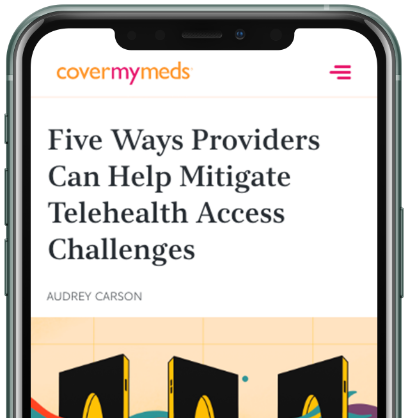How Providers Can Support the Telehealth Needs of Patients in 2021
This examination of two patients who experienced telehealth visits in 2020 can help providers cater to a variety of patients seeking this ever-popular technology option.

When your patients hear the word “telehealth,” what do you think comes to mind?
Whether they prefer doctor visits face-to-face or in-home, they’ve likely found a reason to engage in telehealth options over the last year. As we move beyond the pandemic, practices can, and should, accommodate both. And though telehealth usage has leveled off from its April 2020 peak, telehealth medical claims are still about double what they were pre-pandemic.
According to the American Academy of Family Physicians, telehealth reached only 4 percent of the U.S. population before the COVID-19 pandemic. [ref](https://www.usnews.com/news/health-news/articles/2021-01-05/health-care-after-covid-the-rise-of-telemedicine "Health Care After COVID: The Rise of Telemedicine," U.S. News & World Report, Jan. 5, 2021")
At the start of quarantine, in April 2020, telehealth visits grew 4,000 percent over baseline levels. Even today, after telehealth visits have levelled off some, year-over-year visits are still up by over 2,000 percent. Monitoring the Impact of COVID-19 on the U.S. Pharmaceutical Market, IQVIA, 2021
In a recent survey, patients cited preventing the spread of COVID-19 as the biggest reason for using telehealth.
As with many life changes due to the COVID-19 pandemic (like remote work), telehealth options are now an expectation from patients. Certain circumstances will require in-person care, but many things normally patients might have traveled or booked an appointment for can now be handled virtually: such as, medication advice, well visits or follow-ups and mental health visits.
In a September 2020 provider survey, nearly half said they would continue using telehealth options after the COVID-19 pandemic, and 86 percent surveyed described their telehealth experience as positive. [ref](https://www.usnews.com/news/health-news/articles/2021-01-05/health-care-after-covid-the-rise-of-telemedicine "Health Care After COVID: The Rise of Telemedicine," U.S. News & World Report, Jan. 5, 2021")
What you need to know: Be ready for all types of patients
As life begins to return to normal, many patients will feel more comfortable making in-person visits to their doctor, pharmacy, etc. Others may continue to prefer telehealth, which studies estimate could represent 20 to 30 percent of all visits in the future. [ref](https://www.usnews.com/news/health-news/articles/2021-01-05/health-care-after-covid-the-rise-of-telemedicine "Health Care After COVID: The Rise of Telemedicine," U.S. News & World Report, Jan. 5, 2021")
There’s good and bad with a more widespread adoption of telehealth; 33 percent of providers said patient no-shows have decreased as telehealth became a more convenient option. The result, however, is an increased administrative burden on providers (which nearly 40 percent indicated). CoverMyMeds 2021 MAR Provider Survey
In-workflow technology should make it easier for providers to access information and administer care. And while patients’ needs and preferences will vary, telehealth stands to make life easier for all parties whether the interactions are in-person or virtual.
A closer look at two patients’ experiences with telehealth can help prepare the industry for what’s to come.
Michael: prefers in-person care visits
Telehealth has been a huge development for immunocompromised patients or others with pre-existing conditions who are at higher risk for contracting a communicable disease.
When Michael was diagnosed with scleroderma at 55, he was forced to retire from a successful career.
Michael has no issues or concerns with technology (in fact, he embraces it), and though his clinic is a two-hour drive from home, in-person visits are a necessity. With a telehealth visit, doctors can’t see his skin condition up close, and it’s difficult for him to articulate how he’s feeling without physically being in front of his doctors. When he’s had technical difficulties, the conversation must be held over the phone — another impediment.
“I would prefer to go back to face-to-face (visits),” Michael said.
Patients like Michael like the timeliness of an in-person visit, being able to interact with doctors and nurses in the traditional setting and have that valued “face time” that may not seem as personal as, say, FaceTime.
Pressed for time and overwhelmed by administrative paperwork, providers and their staff are constantly looking for ways to increase efficiencies in their practice. Common examples include, leveraging other healthcare technology solutions, like electronic prior authorization or real time benefit check. Providers can expedite administrative work, benefits verification and other tasks that enable them to spend more of their limited face-to-face time in front of the patient.
Kathy: Tech-savvy and values convenience
For Kathy, who’s been living with multiple sclerosis and wants to minimize her risk of being exposed to COVID-19, telehealth has been a saving grace.
Because of “cog fog,” or cognitive fog, she’s not always comfortable visiting her doctor’s office. Being at home can put her more at ease, making telehealth an approachable and calming option to engage with her care team. With an array of information to manage and sort through due to her condition, Kathy loves to have everything in one place with her electronic patient-facing tools.
“Anybody can get any kind of information,” Kathy said. “I like having (as much as) possible.”
When you have patients who embrace telehealth, they’re typically beyond the hurdle of adopting new technology. This makes it easier to engage them with price transparency tools, send-to-wallet prescription options and even pharmacy choice and home delivery options.
In turn, this may reduce the burden for providers and their care teams, give the patient a comfortable and convenient option and allow them to be a more active participant in where they see their doctor, what medications are prescribed and where their prescription is filled.
It should be simple and seamless for the provider and for the patient. In most cases, it is.
To learn more about telehealth adoption and the patient impact of technology solutions, check out our 2021 Medication Access Report.
The latest healthcare insights, floated right to your inbox.





